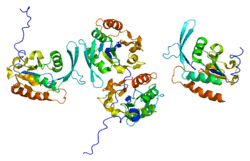CTDSPL
| CTD (carboxy-terminal domain, RNA polymerase II, polypeptide A) small phosphatase-like | |||||||||||||
|---|---|---|---|---|---|---|---|---|---|---|---|---|---|
 PDB rendering based on 2hhl. | |||||||||||||
| |||||||||||||
| Identifiers | |||||||||||||
| Symbols | CTDSPL ; C3orf8; HYA22; PSR1; RBSP3; SCP3 | ||||||||||||
| External IDs | OMIM: 608592 MGI: 1916524 HomoloGene: 48881 GeneCards: CTDSPL Gene | ||||||||||||
| EC number | 3.1.3.16 | ||||||||||||
| |||||||||||||
| Orthologs | |||||||||||||
| Species | Human | Mouse | |||||||||||
| Entrez | 10217 | 69274 | |||||||||||
| Ensembl | ENSG00000144677 | ENSMUSG00000047409 | |||||||||||
| UniProt | O15194 | P58465 | |||||||||||
| RefSeq (mRNA) | NM_001008392 | NM_133710 | |||||||||||
| RefSeq (protein) | NP_001008393 | NP_598471 | |||||||||||
| Location (UCSC) | Chr 3: 37.9 – 38.03 Mb | Chr 9: 118.93 – 119.04 Mb | |||||||||||
| PubMed search | |||||||||||||
CTD small phosphatase-like protein is an enzyme that in humans is encoded by the CTDSPL gene.[1][2][3]
Interactions
CTDSPL has been shown to interact with SNAI1.[4]
References
- ↑ Ishikawa S, Kai M, Tamari M, Takei Y, Takeuchi K, Bandou H, Yamane Y, Ogawa M, Nakamura Y (Aug 1997). "Sequence analysis of a 685-kb genomic region on chromosome 3p22-p21.3 that is homozygously deleted in a lung carcinoma cell line". DNA Res 4 (1): 35–43. doi:10.1093/dnares/4.1.35. PMID 9179494.
- ↑ Protopopov A, Kashuba V, Zabarovska VI, Muravenko OV, Lerman MI, Klein G, Zabarovsky ER (Jan 2003). "An integrated physical and gene map of the 3.5-Mb chromosome 3p21.3 (AP20) region implicated in major human epithelial malignancies". Cancer Res 63 (2): 404–12. PMID 12543795.
- ↑ "Entrez Gene: CTDSPL CTD (carboxy-terminal domain, RNA polymerase II, polypeptide A) small phosphatase-like".
- ↑ Wu, Yadi; Evers B Mark; Zhou Binhua P (Jan 2009). "Small C-terminal domain phosphatase enhances snail activity through dephosphorylation". J. Biol. Chem. (United States) 284 (1): 640–8. doi:10.1074/jbc.M806916200. ISSN 0021-9258. PMC 2610500. PMID 19004823.
Further reading
- O'Keeffe B, Fong Y, Chen D et al. (2000). "Requirement for a kinase-specific chaperone pathway in the production of a Cdk9/cyclin T1 heterodimer responsible for P-TEFb-mediated tat stimulation of HIV-1 transcription.". J. Biol. Chem. 275 (1): 279–87. doi:10.1074/jbc.275.1.279. PMID 10617616.
- Kim JB, Sharp PA (2001). "Positive transcription elongation factor B phosphorylates hSPT5 and RNA polymerase II carboxyl-terminal domain independently of cyclin-dependent kinase-activating kinase.". J. Biol. Chem. 276 (15): 12317–23. doi:10.1074/jbc.M010908200. PMID 11145967.
- Ramanathan Y, Rajpara SM, Reza SM et al. (2001). "Three RNA polymerase II carboxyl-terminal domain kinases display distinct substrate preferences.". J. Biol. Chem. 276 (14): 10913–20. doi:10.1074/jbc.M010975200. PMID 11278802.
- Zhou M, Nekhai S, Bharucha DC et al. (2002). "TFIIH inhibits CDK9 phosphorylation during human immunodeficiency virus type 1 transcription.". J. Biol. Chem. 276 (48): 44633–40. doi:10.1074/jbc.M107466200. PMID 11572868.
- Lin X, Taube R, Fujinaga K, Peterlin BM (2002). "P-TEFb containing cyclin K and Cdk9 can activate transcription via RNA.". J. Biol. Chem. 277 (19): 16873–8. doi:10.1074/jbc.M200117200. PMID 11884399.
- Kim YK, Bourgeois CF, Isel C et al. (2002). "Phosphorylation of the RNA polymerase II carboxyl-terminal domain by CDK9 is directly responsible for human immunodeficiency virus type 1 Tat-activated transcriptional elongation.". Mol. Cell. Biol. 22 (13): 4622–37. doi:10.1128/MCB.22.13.4622-4637.2002. PMC 133925. PMID 12052871.
- Yeo M, Lin PS, Dahmus ME, Gill GN (2003). "A novel RNA polymerase II C-terminal domain phosphatase that preferentially dephosphorylates serine 5.". J. Biol. Chem. 278 (28): 26078–85. doi:10.1074/jbc.M301791200. PMID 12721286.
- Pinhero R, Liaw P, Bertens K, Yankulov K (2004). "Three cyclin-dependent kinases preferentially phosphorylate different parts of the C-terminal domain of the large subunit of RNA polymerase II.". Eur. J. Biochem. 271 (5): 1004–14. doi:10.1111/j.1432-1033.2004.04002.x. PMID 15009212.
- Kashuba VI, Li J, Wang F et al. (2004). "RBSP3 (HYA22) is a tumor suppressor gene implicated in major epithelial malignancies.". Proc. Natl. Acad. Sci. U.S.A. 101 (14): 4906–11. doi:10.1073/pnas.0401238101. PMC 387347. PMID 15051889.
External links
- CTDSPL human gene location in the UCSC Genome Browser.
- CTDSPL human gene details in the UCSC Genome Browser.
| |||||||||
